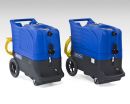(Press-News.org) This press release is available in French.
University of Toulouse and University of Montreal researchers have detected two planets of sizes comparable to Earth orbiting around an old star that has just passed the red giant stage. This planetary system is located near Lyra and Cygnus constellations at a distance of 3900 light years. This discovery, to be published by in Nature on December 22 2011, may shed new light on the destiny of stellar and planetary systems.
"The two planets, named KOI 55.01 and KOI 55.02, are on very short orbits around their host star," explained University of Montreal astrophysicist Gilles Fontaine and member of the Center for research in astrophysics of Québec (CRAQ). "Having migrated so close, they probably plunged deep into the star's envelope during the red giant phase, but survived. The two observed bodies would then be the dense cores of ancient giant planets whose gaseous envelopes were vaporized during the immersion phase." The host star, KIC 05807616, consists of the exposed core of a red giant that has lost nearly its entire envelope, and in fact the planets may have contributed to the increased loss of mass that is necessary for the formation of this type of star. This has lead the researchers to theorize that planetary systems in general may therefore influence the evolution of their parent stars.
Twinkle twinkle little star
While analyzing the data obtained with the NASA Kepler mission to study the pulsations of the star KIC 05807616 (KPD 1943+4058 or KOI 55), an international team of astrophysicists from eight different countries noticed the intriguing presence of two tiny periodic modulations reaching 0.005% of the star brightness. As these variations could not be attributed to the oscillations of the star or to other causes, the presence of the two bodies orbiting around KIC 05807616 became the only plausible explanation.
The observed variations are the joint effects of the reflection of the star light on the illuminated surface of these bodies and of the difference in thermal emission between the heated day-side and cooler night-side hemispheres, modulated by the position of the bodies on their respective orbits. As a comparison, the situation is similar to the brightness variations of the Moon associated with its different illumination phases depending on its position relative to the Sun and the observers on Earth. For KIC 05807616, calculations show that in order to produce such low amplitude brightness modulations, the sizes of the orbiting bodies are likely comparable to that of the Earth.
One Astronomical Unit (AU) is the distance between the Sun and Earth. Since these planets are separated from their very hot (27,000 oC), intensely radiating host star by only 0.0060 and 0.0076 AU, extremely harsh conditions must prevail on their surface, especially in the star-facing hemisphere where temperatures could range between 8000 and 9000 oC. Conditions like these have never been found the planets that have been discovered outside our solar system. The discovery raises many questions about what kinds of life might exist in such hellish conditions.
These planets are referred to as Chthonian planets, could be the remnants of ancient gaseous giant planets – perhaps like hotter versions of Jupiter – that orbited the star when it was still burning hydrogen in its core, a long time ago. The envelope of these giant planets would have been dissipated during the immersion phase inside the star when the latter became a red giant. Only the dense cores of the planets, composed of iron and other heavy elements, would have survived this extreme episode.
KIC 05807616, a hot and compact sdB star, is all that remains of the former red giant: an active helium-burning core surrounded by a thin hydrogen layer. Forming this type of star requires the red giant progenitor to eject almost its entire envelope via a mechanism that significantly amplifies the normal mass loss from stellar winds. The two planets discovered around this star may have triggered such a process.
###
About this study:
"A compact system of small planets around an evolved post red giant star" was published in Nature on December 22, 2011. The research team was led by Stéphane Charpinet (Université de Toulouse) in collaboration with his former thesis advisors at the Université de Montréal, Gilles Fontaine and Pierre Brassard. Two other former Ph.D. students in the group of Professor Fontaine in Montréal, Suzanna Randall (European Southern Observatory) and Valérie Van Grootel (Université de Liège), also participated in this research project. Gilles Fontaine is a Canada Research Chair for Stellar Astrophysics and a member of CRAQ (Centre de recherche en astrophsyique du Québec). This study received funding from Fond de recherche du Québéc – Nature et technologies and Natural Sciences and Engineering Research Council of Canada. University of Toulouse and Université de Montréal are known officially as Université de Toulouse and Université de Montréal, respectively.
About CRAQ:
The Centre for Research in Astrophysics of Québec (CRAQ) is a partnership between the Université de Montréal, McGill University, and the Université Laval. The CRAQ brings together all researchers working in the field of astronomy and astrophysics of these three institutions, as well as other collaborators from Bishop's University, the Canadian Space Agency, the Cégep de Sherbrooke, and the private sector (Photon etc., ABB Bomem Inc., Nüvü Caméras). The CRAQ is funded through the program Regroupements stratégiques of the Fonds de recherche du Québec – Nature et technologies (FRQ-NT). The CRAQ constitutes a unique grouping of researchers in strophysics in Québec bent on excellence and whose varying and complementary fields of expertise allows them to be innovative, creative and competitive in several scientific fields, thus offering graduate students a wide variety of subjects in both fundamental and applied fields of research.
Discovery of 2 Earth-size planets raises questions about the evolution of stars
2011-12-22
ELSE PRESS RELEASES FROM THIS DATE:
Researchers develop new method of cleaning toxins from the oilsands
2011-12-22
Alberta's oilsands have water challenges. Oilsands development uses a vast amount of water and even though it's recycled multiple times, the recycling concentrates the toxins and metals leftover from extracting and upgrading the bitumen, resulting in tailings ponds that are both a lightening rod for controversy and a significant risk to the environment. A research project underway between biologists at the University of Calgary and engineers at the University of Alberta to help resolve the water issue is making rapid progress toward that goal.
Two years into the research, ...
Clarke BEXT Pro Portable Extractor Delivers Superior Cleaning Power with Enhanced Cleaning Flexibility
2011-12-22
Clarke, a brand of Nilfisk-Advance, Inc., introduces the latest addition to the company's line of carpet extractors, the BEXT Pro Portable Extractor. Delivering instant, continuous heat of 212 degrees Fahrenheit solution, the BEXT Pro effectively attacks tough carpet stains. The BEXT Pro is available in two pressures--100 psi and 400 psi--in addition to models with heated and non-heated performance, providing operators with the ultimate cleaning flexibility to satisfy applications ranging from light duty cleaning to deep extraction requirements.
With a durable, user-friendly ...
Exploiting Trichoderma: From food security to biotechnology
2011-12-22
From improving food security to their use as biotechnology power horses, Trichoderma fungi are increasingly being exploited by industry. Current advances in the field are brought together and highlighted in a special issue of Microbiology published online on 27 December.
Trichoderma are free-living fungi widely used in agricultural biotechnology. Some species of Trichoderma are specifically used as biocontrol agents to control plant pathogens including Fusarium species. Their success is partly due to mycoparasitism – a lifestyle where one fungus is parasitic on another ...
Self-regulation of the immune system suppresses defense against cancer
2011-12-22
It is vital that the body's own immune system does not overreact. If its key players, the helper T cells, get out of control, this can lead to autoimmune diseases or allergies. An immune system overreaction against infectious agents may even directly damage organs and tissues.
Immune cells called regulatory T cells ("Tregs") ensure that immune responses take place in a coordinated manner: They downregulate the dividing activity of helper T cells and reduce their production of immune mediators. "This happens through direct contact between regulatory cell and helper cell," ...
Balancing the womb
2011-12-22
New research hopes to explain premature births and failed inductions of labour. The study by academics at the University of Bristol suggests a new mechanism by which the level of myosin phosphorylation is regulated in the pregnant uterus.
The researchers, Dr Claire Hudson and Professor Andrés López Bernal in the School of Clinical Sciences and Dr Kate Heesom in the University Proteomics Facility and the School of Biochemistry, have discovered that phosphorylation of uterus proteins at specific amino acids have a key role in the regulation of uterine activity in labour.
A ...
Monitoring food with millimeter waves
2011-12-22
Has the packet been properly filled? Are there impurities in the chocolate? Have the plastic seams been welded correctly? Is there a knife hidden in the parcel? Answers to all these questions are provided by SAMMI, short for Stand Alone MilliMeter wave Imager. The millimeter-wave sensor is able to see through all non-transparent materials. Researchers at the Fraunhofer Institute for High Frequency Physics and Radar Techniques FHR in Wachtberg have developed the device, whichat 50 centimeters wide and 32 centimeters high is no larger than a compact laser printer. SAMMI can ...
New Upright Vacuum from Advance Delivers Exceptional Cleaning Performance for the Hospitality Market
2011-12-22
Advance introduces the newest addition to the company's upright vacuum product line with the Spectrum 12H Single Motor Upright Vacuum. With high-quality dirt pickup and filtration capabilities, the Spectrum 12H is designed to withstand the demanding environmental conditions and the unique operational needs found in the hospitality market.
"The hospitality industry requires continuous cleaning and carpet maintenance to ensure excellent guest satisfaction," said Bob Abrams, Product Manager for Nilfisk-Advance. "The Spectrum 12H meets these requirements with ...
How to break Murphy's Law
2011-12-22
Murphy's Law is a useful scapegoat for human error: "If something can go wrong, it will." But, a new study by researchers in Canada hopes to put paid to this unscientific excuse for errors by showing that the introduction of verification and checking procedures can improve structural safety and performance and so prevent the application of the "law".
Engineer Franz Knoll of Nicolet Chartrand Knoll Ltd., based in Montreal, Quebec, writing in the International Journal of Reliability and Safety explains that faults and flaws in any industrial product almost always originate ...
Even limited telemedicine could improve developing health
2011-12-22
A lack of infrastructure in developing countries, and particularly in rural areas, often ensures that healthcare provision is absent. Research published in the International Journal of Services, Economics and Management by a team at Howard University in Washington DC suggests a solution to this insidious problem involving the development of telemedicine.
Ronald Leach and colleagues describe a highly asynchronous service model for healthcare delivery. The approach is much cheaper to implement than direct medicine and even less expensive than other approaches to telemedicine ...
Southampton researchers help to outline world's land and water resources for food and agriculture
2011-12-22
Researchers from the University of Southampton have contributed to a major international United Nation's (UN) report into the current status of the world's land and water resources for food and agriculture.
Dr Craig Hutton, Professor Mike Clark, both from the University's GeoData Institute, and demographer Dr Fiifi Amoako Johnson contributed as authors as well external editors to the recent United Nations Food and Agriculture Organisation publication, 'State of the World's Land and Water Resources for Food and Agriculture' (SOLAW).
The report notes that with the task ...



